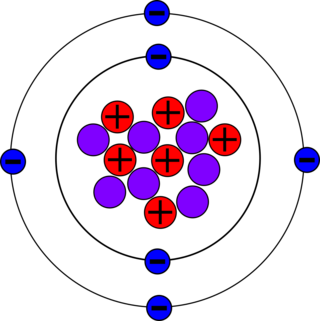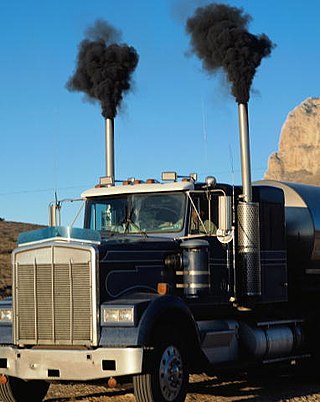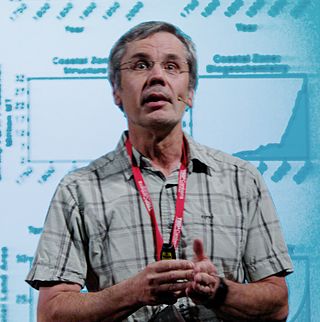Related Research Articles

Environmental geology, like hydrogeology, is an applied science concerned with the practical application of the principles of geology in the solving of environmental problems created by man. It is a multidisciplinary field that is closely related to engineering geology and, to a lesser extent, to environmental geography. Each of these fields involves the study of the interaction of humans with the geologic environment, including the biosphere, the lithosphere, the hydrosphere, and to some extent the atmosphere. In other words, environmental geology is the application of geological information to solve conflicts, minimizing possible adverse environmental degradation, or maximizing possible advantageous conditions resulting from the use of natural and modified environment. With an increasing world population and industrialization, the natural environment and resources are under high strain which puts them at the forefront of world issues. Environmental geology is on the rise with these issues as solutions are found by utilizing it.

Carbon-14, C-14, 14C or radiocarbon, is a radioactive isotope of carbon with an atomic nucleus containing 6 protons and 8 neutrons. Its presence in organic matter is the basis of the radiocarbon dating method pioneered by Willard Libby and colleagues (1949) to date archaeological, geological and hydrogeological samples. Carbon-14 was discovered on February 27, 1940, by Martin Kamen and Sam Ruben at the University of California Radiation Laboratory in Berkeley, California. Its existence had been suggested by Franz Kurie in 1934.

Anthracene is a solid polycyclic aromatic hydrocarbon (PAH) of formula C14H10, consisting of three fused benzene rings. It is a component of coal tar. Anthracene is used in the production of the red dye alizarin and other dyes, as a Scintillator to detect high energy particles, as production of pharmaceutical drugs. Anthracene is colorless but exhibits a blue (400–500 nm peak) fluorescence under ultraviolet radiation.

The Anthropocene is a now rejected proposal for the name of a geological epoch that would follow the Holocene, dating from the commencement of significant human impact on Earth up to the present day. It was rejected in 2024 by the International Commission on Stratigraphy in terms of being a defined geologic period. The impacts of humans affect Earth's oceans, geology, geomorphology, landscape, limnology, hydrology, ecosystems and climate. The effects of human activities on Earth can be seen for example in biodiversity loss and climate change. Various start dates for the Anthropocene have been proposed, ranging from the beginning of the Neolithic Revolution, to as recently as the 1960s. The biologist Eugene F. Stoermer is credited with first coining and using the term anthropocene informally in the 1980s; Paul J. Crutzen re-invented and popularized the term. However, in 2024 the International Commission on Stratigraphy (ICS) and the International Union of Geological Sciences (IUGS) rejected the Anthropocene Epoch proposal for inclusion in the Geologic Time Scale.

Soot is a mass of impure carbon particles resulting from the incomplete combustion of hydrocarbons. Soot is considered a hazardous substance with carcinogenic properties. Most broadly, the term includes all the particulate matter produced by this process, including black carbon and residual pyrolysed fuel particles such as coal, cenospheres, charred wood, and petroleum coke classified as cokes or char. It can include polycyclic aromatic hydrocarbons and heavy metals like mercury.

Topsoil is the upper layer of soil. It has the highest concentration of organic matter and microorganisms and is where most of the Earth's biological soil activity occurs.
Global change in broad sense refers to planetary-scale changes in the Earth system. It is most commonly used to encompass the variety of changes connected to the rapid increase in human activities which started around mid-20th century, i.e., the Great Acceleration. While the concept stems from research on the climate change, it is used to adopt a more holistic view of the observed changes. Global change refers to the changes of the Earth system, treated in its entirety with interacting physicochemical and biological components as well as the impact human societies have on the components and vice versa. Therefore, the changes are studied through means of Earth system science.

A carbon footprint (or greenhouse gas footprint) is a calculated value or index that makes it possible to compare the total amount of greenhouse gases that an activity, product, company or country adds to the atmosphere. Carbon footprints are usually reported in tonnes of emissions (CO2-equivalent) per unit of comparison. Such units can be for example tonnes CO2-eq per year, per kilogram of protein for consumption, per kilometer travelled, per piece of clothing and so forth. A product's carbon footprint includes the emissions for the entire life cycle. These run from the production along the supply chain to its final consumption and disposal.
The Early Anthropocene Hypothesis is a stance concerning the beginning of the Anthropocene first proposed by William Ruddiman in 2003. It posits that the Anthropocene, a proposed geological epoch coinciding with the most recent period in Earth's history when the activities of the human race first began to have a significant global impact on Earth's climate and ecosystems, dates back to 8,000 years ago, triggered by intense farming activities after agriculture became widespread. It was at that time that atmospheric greenhouse gas concentrations stopped following the periodic pattern of rises and falls that had accurately characterized their past long-term behavior, a pattern that is explained by natural variations in Earth's orbit known as Milankovitch cycles. Ruddiman's proposed start-date has been met with criticism from scholars in a variety of fields.

R. Timothy Patterson is a Canadian professor of geology, Chairman of the Department of Earth Sciences at Carleton University, Ottawa, Ontario, Canada, and a researcher with specialization in paleolimnology, paleoceanography, and paleoclimatology. He founded and is co-Director of the Carleton Climate and Environmental Research Group (CCERG) He has previously served as Director of the Ottawa-Carleton Geoscience Centre and as senior visiting fellow in the School of Geography, Queen's University of Belfast, Northern Ireland.

Air pollution is the presence of substances in the atmosphere that are harmful to humans and other living beings, or cause damage to the environment. Air pollution can be chemical, physical or biological. There are many different types of air pollutants, such as gases, particulates and biological molecules. Air pollution can cause diseases, allergies, and even death; it can also cause harm to animals and crops and damage the natural environment or built environment. Air pollution can occur naturally or be caused by human activities.

The airborne fraction is a scaling factor defined as the ratio of the annual increase in atmospheric CO
2 to the CO
2 emissions from human sources. It represents the proportion of human emitted CO2 that remains in the atmosphere. Observations over the past six decades show that the airborne fraction has remained relatively stable at around 45%. This indicates that the land and ocean's capacity to absorb CO2 has kept up with the rise in human CO2 emissions, despite the occurrence of notable interannual and sub-decadal variability, which is predominantly driven by the land's ability to absorb CO2. There is some evidence for a recent increase in airborne fraction, which would imply a faster increase in atmospheric CO
2 for a given rate of human fossil-fuel burning. Changes in carbon sinks can affect the airborne fraction as well.

Environmental issues are disruptions in the usual function of ecosystems. Further, these issues can be caused by humans or they can be natural. These issues are considered serious when the ecosystem cannot recover in the present situation, and catastrophic if the ecosystem is projected to certainly collapse.

The environmental impact of the petroleum industry is extensive and expansive due to petroleum having many uses. Crude oil and natural gas are primary energy and raw material sources that enable numerous aspects of modern daily life and the world economy. Their supply has grown quickly over the last 150 years to meet the demands of the rapidly increasing human population, creativity, knowledge, and consumerism.

Planetary boundaries are a framework to describe limits to the impacts of human activities on the Earth system. Beyond these limits, the environment may not be able to self-regulate anymore. This would mean the Earth system would leave the period of stability of the Holocene, in which human society developed. The framework is based on scientific evidence that human actions, especially those of industrialized societies since the Industrial Revolution, have become the main driver of global environmental change. According to the framework, "transgressing one or more planetary boundaries may be deleterious or even catastrophic due to the risk of crossing thresholds that will trigger non-linear, abrupt environmental change within continental-scale to planetary-scale systems."

William Lee Steffen was an American-born Australian chemist. He was the executive director of the Australian National University (ANU) Climate Change Institute and a member of the Australian Climate Commission until its dissolution in September 2013. From 1998 to 2004, he was the executive director of the International Geosphere-Biosphere Programme, a coordinating body of national environmental change organisations based in Stockholm. Steffen was one of the founding climate councillors of the Climate Council, with whom he frequently co-authored reports, and spoke in the media on issues relating to climate change and renewable energy.

Ecomodernism is an environmental philosophy which argues that technological development can protect nature and improve human wellbeing through eco-economic decoupling, i.e., by separating economic growth from environmental impacts.
The Great Acceleration is the dramatic, continuous and roughly simultaneous surge across a large range of measures of human activity, first recorded in the mid-20th century and continuing into the early 21st century. Within the concept of the proposed epoch of the Anthropocene, these measures are specifically those of humanity's impact on Earth's geology and its ecosystems. Within the Anthropocene epoch, the Great Acceleration can be variously classified as its only age to date, one of its many ages, or its defining feature that is thus not an age, as well as other classifications.
The Anthropocene Working Group (AWG) is an interdisciplinary research group dedicated to the study of the Anthropocene as a geological time unit. It was established in 2009 as part of the Subcommission on Quaternary Stratigraphy (SQS), a constituent body of the International Commission on Stratigraphy (ICS). As of 2021, the research group features 37 members, with the physical geographer Simon Turner as Secretary and the geologist Colin Neil Waters as chair of the group. The late Nobel Prize-winning Paul Crutzen, who popularized the word 'Anthropocene' in 2000, had also been a member of the group until he died on January 28, 2021. The main goal of the AWG is providing scientific evidence robust enough for the Anthropocene to be formally ratified by the International Union of Geological Sciences (IUGS) as an epoch within the Geologic time scale.
The Orbis Spike is a global dip in atmospheric carbon dioxide levels around the year 1610 CE, as recorded by the Antarctic sea ice record. The Orbis spike is one of the potential starting points for the Anthropocene Epoch, as determined by the Global Boundary Stratotype Section and Point. There are several hypotheses as to what caused the dip, the chief among them being diseases brought by European explorers. This exposure to foreign pathogens then caused a rapid and drastic decrease in the native populations, leading to reforestation in the Western Hemisphere. There has been controversy raised about whether the Orbis Spike should be recognized as the beginning of the Anthropocene, as some see potential better markers.
References
- ↑ Swindles et al. 2015.
- ↑ Raupach 2010.
- ↑ Rose 2015, pp. 4155–4162.